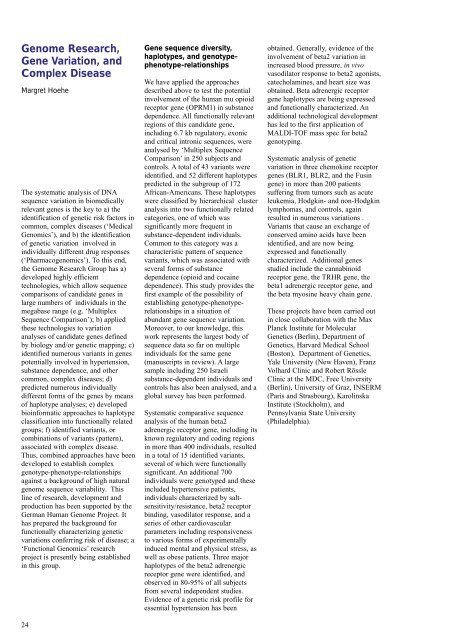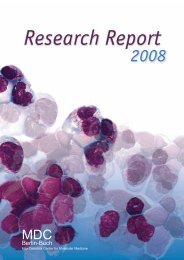You also want an ePaper? Increase the reach of your titles
YUMPU automatically turns print PDFs into web optimized ePapers that Google loves.
Genome <strong>Research</strong>,<br />
Gene Variation, and<br />
Complex Disease<br />
Margret Hoehe<br />
The systematic analysis of DNA<br />
sequence variation in biomedically<br />
relevant genes is the key to a) the<br />
identification of genetic risk factors in<br />
common, complex diseases (‘Medical<br />
Genomics’), and b) the identification<br />
of genetic variation involved in<br />
individually different drug responses<br />
(‘Pharmacogenomics’). To this end,<br />
the Genome <strong>Research</strong> Group has a)<br />
developed highly efficient<br />
technologies, which allow sequence<br />
comparisons of candidate genes in<br />
large numbers of individuals in the<br />
megabase range (e.g. ‘Multiplex<br />
Sequence Comparison’); b) applied<br />
these technologies to variation<br />
analyses of candidate genes defined<br />
by biology and/or genetic mapping; c)<br />
identified numerous variants in genes<br />
potentially involved in hypertension,<br />
substance dependence, and other<br />
common, complex diseases; d)<br />
predicted numerous individually<br />
different forms of the genes by means<br />
of haplotype analyses; e) developed<br />
bioinformatic approaches to haplotype<br />
classification into functionally related<br />
groups; f) identified variants, or<br />
combinations of variants (pattern),<br />
associated with complex disease.<br />
Thus, combined approaches have been<br />
developed to establish complex<br />
genotype-phenotype-relationships<br />
against a background of high natural<br />
genome sequence variability. This<br />
line of research, development and<br />
production has been supported by the<br />
German Human Genome Project. It<br />
has prepared the background for<br />
functionally characterizing genetic<br />
variations conferring risk of disease; a<br />
‘Functional Genomics’ research<br />
project is presently being established<br />
in this group.<br />
24<br />
Gene sequence diversity,<br />
haplotypes, and genotypephenotype-relationships<br />
We have applied the approaches<br />
described above to test the potential<br />
involvement of the human mu opioid<br />
receptor gene (OPRM1) in substance<br />
dependence. All functionally relevant<br />
regions of this candidate gene,<br />
including 6.7 kb regulatory, exonic<br />
and critical intronic sequences, were<br />
analysed by ‘Multiplex Sequence<br />
Comparison’ in 250 subjects and<br />
controls. A total of 43 variants were<br />
identified, and 52 different haplotypes<br />
predicted in the subgroup of 172<br />
African-Americans. These haplotypes<br />
were classified by hierarchical cluster<br />
analysis into two functionally related<br />
categories, one of which was<br />
significantly more frequent in<br />
substance-dependent individuals.<br />
Common to this category was a<br />
characteristic pattern of sequence<br />
variants, which was associated with<br />
several forms of substance<br />
dependence (opioid and cocaine<br />
dependence). This study provides the<br />
first example of the possibility of<br />
establishing genotype-phenotyperelationships<br />
in a situation of<br />
abundant gene sequence variation.<br />
Moreover, to our knowledge, this<br />
work represents the largest body of<br />
sequence data so far on multiple<br />
individuals for the same gene<br />
(manuscripts in review). A large<br />
sample including 250 Israeli<br />
substance-dependent individuals and<br />
controls has also been analysed, and a<br />
global survey has been performed.<br />
Systematic comparative sequence<br />
analysis of the human beta2<br />
adrenergic receptor gene, including its<br />
known regulatory and coding regions<br />
in more than 400 individuals, resulted<br />
in a total of 15 identified variants,<br />
several of which were functionally<br />
significant. An additional 700<br />
individuals were genotyped and these<br />
included hypertensive patients,<br />
individuals characterized by saltsensitivity/resistance,<br />
beta2 receptor<br />
binding, vasodilator response, and a<br />
series of other cardiovascular<br />
parameters including responsiveness<br />
to various forms of experimentally<br />
induced mental and physical stress, as<br />
well as obese patients. Three major<br />
haplotypes of the beta2 adrenergic<br />
receptor gene were identified, and<br />
observed in 80-95% of all subjects<br />
from several independent studies.<br />
Evidence of a genetic risk profile for<br />
essential hypertension has been<br />
obtained. Generally, evidence of the<br />
involvement of beta2 variation in<br />
increased blood pressure, in vivo<br />
vasodilator response to beta2 agonists,<br />
catecholamines, and heart size was<br />
obtained. Beta adrenergic receptor<br />
gene haplotypes are being expressed<br />
and functionally characterized. An<br />
additional technological development<br />
has led to the first application of<br />
MALDI-TOF mass spec for beta2<br />
genotyping.<br />
Systematic analysis of genetic<br />
variation in three chemokine receptor<br />
genes (BLR1, BLR2, and the Fusin<br />
gene) in more than 200 patients<br />
suffering from tumors such as acute<br />
leukemia, Hodgkin- and non-Hodgkin<br />
lymphomas, and controls, again<br />
resulted in numerous variations .<br />
Variants that cause an exchange of<br />
conserved amino acids have been<br />
identified, and are now being<br />
expressed and functionally<br />
characterized. Additional genes<br />
studied include the cannabinoid<br />
receptor gene, the TRHR gene, the<br />
beta1 adrenergic receptor gene, and<br />
the beta myosine heavy chain gene.<br />
These projects have been carried out<br />
in close collaboration with the Max<br />
Planck Institute for Molecular<br />
Genetics (Berlin), Department of<br />
Genetics, Harvard Medical School<br />
(Boston), Department of Genetics,<br />
Yale University (New Haven), Franz<br />
Volhard Clinic and Robert Rössle<br />
Clinic at the <strong>MDC</strong>, Free University<br />
(Berlin), University of Graz, INSERM<br />
(Paris and Strasbourg), Karolinska<br />
Institute (Stockholm), and<br />
Pennsylvania State University<br />
(Philadelphia).

















